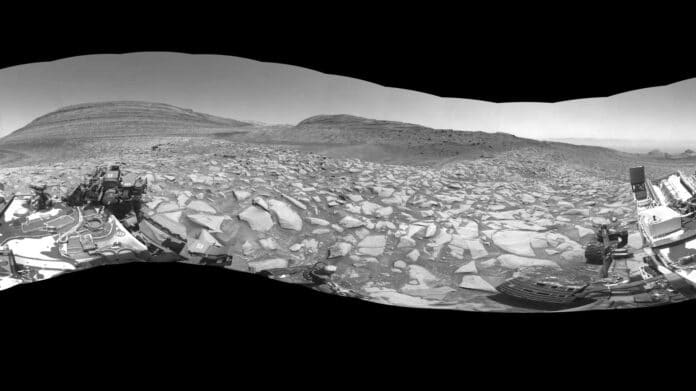NASA‘s Curiosity rover is searching an area of Mars—known as Gediz Vallis—to determine when the planet’s surface was dry. Mars was once filled with water and is even hotter than it is now. The Gediz Wallies look like they were shaped by the river long ago.
This excites scientists because they want to know how the river sculpted the channel. Because of the steep edges, they don’t think wind produced it. They speculate that it might have been carved by floods or a river carrying rocks and sediments. The waterway was filled with large stones and other debris after it formed. Scientists are interested in knowing if dry avalanches or floods caused all this.
Curiosity has ascended Mount Sharp, a massive mountain on Mars, since 2014. The lower part of the mountain’s layers took millions of years to form. They offer clues about Mars’s history, particularly about the evolution of the planet’s water content and the elements needed for life. Curiosity discovered clay minerals in one layer, indicating a high water content previously. It examines a layer of sulfate, or salty minerals, typically left behind after water evaporates.
This will take several months, and the outcomes could help scientists understand the timeline for the mountain’s formation.
Erosion gradually removed the sediment layers that wind and water had deposited on the bottom part of Mount Sharp, exposing the strata that are visible today. It took a while for this process to be completed, during which time Mount Sharp’s surface was desert-like and arid.
It is possible that the Gediz Vallis channel was formed only after these activities. The rocks and debris that later filled the channel are thought to have come from high up on the mountain, beyond Curiosity’s grasp. This offers clues on the minerals present at high up on Mount Sharp.
Curiosity’s project scientist, Ashwin Vasavada, explains that if the channel and its debris were formed by liquid water, it would be exciting. This means that after a long dry period, water returned to Mount Sharp on a large scale.
This explanation matches one of Curiosity’s discoveries: Rather than progressively disappearing as the globe grew drier, water appears to have come and gone in phases. Mud cracks, shallow saltwater lakes, and, directly beneath the channel, massive debris flows that accumulated to form the expansive Gediz Vallis ridge are all examples of these cycles.
Curiosity used the left navigation camera on the rover to capture a 360-degree black-and-white panorama of the channel. The image, taken on February 3rd, the 4,086th Martian day, or sol, of the mission, depicts a debris pile building slightly behind the sand and dark sand filling one side of the canal. The steep hill that Curiosity ascended to get here is to the other side.
